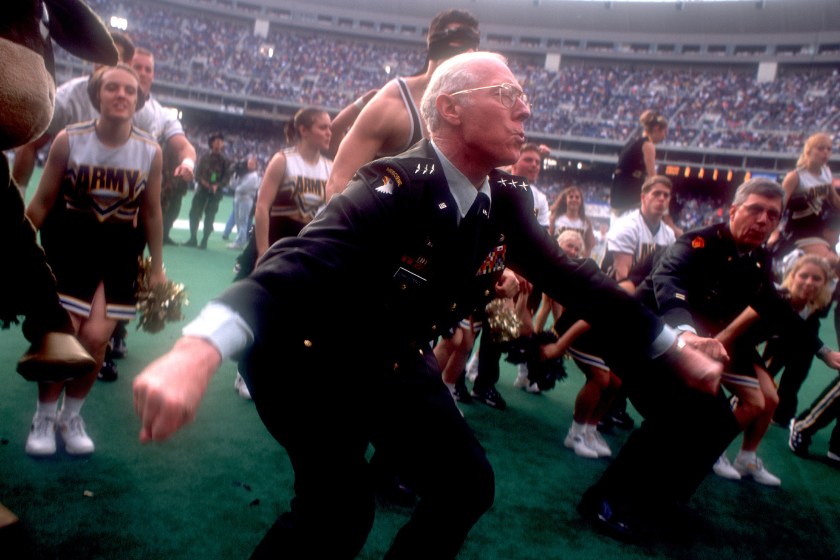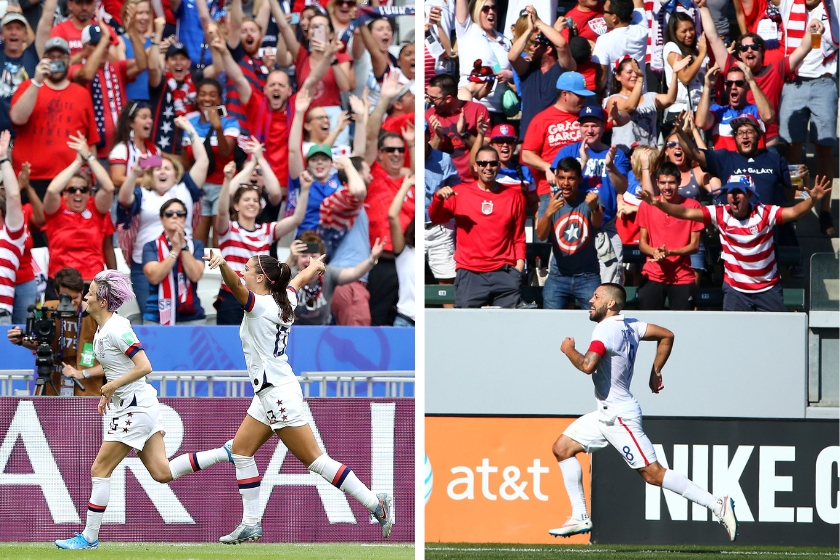"I BELIEVE THAT WE WILL WIN! I BELIEVE THAT WE WILL WIN! I BELIEVE THAT WE WILL WIN!"
Videos by FanBuzz
You likely have heard the chant that has become the anthem of U.S. Soccer by now. From high school football fields in California to college basketball games in Indiana and NFL stadiums in New York, from the Gold Cup to the World Cup, and even in commercials, the catchy U.S. soccer chant has become a staple at sporting events in North America. But fun fact: Did you know that chant was heard for the very first time at the U.S. Naval Academy? That's right. It was the Naval Academy — not the U.S. men's soccer team — that gave Americans their favorite in-game song.
I Believe That We Will Win Origin: American Football Meets Global Football

Photo by Andrew Lichtenstein/Corbis via Getty Images
RELATED: The Army-Navy "Prisoner Exchange" is College Football's Most Underrated Tradition
According to former midshipmen from the U.S. Naval Academy, the chant's origins date back to the 1999 Army-Navy game, and it has been a rallying cry of the Navy athletics program ever since. Before it debuted to a mass audience in 1999, it got its humble start as a training cheer developed by future Naval pilot Jay Rodriguez at the Naval Academy Preparatory School. It was cheerleader Corey Strong, a friend of Rodriguez, who brought it to the academy with him in '99, where the song debuted in the fourth quarter of the Army-Navy football game.
Strong told ESPN, "It was the fourth quarter, it was a really pivotal point, and I shouted out, "Let me hear you say "I" ("I") "I BELIEVE" ("I Believe") and they kinda really jumped in, and it went from there .... I think it took off because midshipmen take it everywhere they go."
"The first time we heard it, we all thought, 'This is awesome,'" John Reeves, who attended Navy Prep and the Naval Academy with Rodriguez, told Jeff Eisenberg of Yahoo.com. "Jay was really good at coming up with stuff like that because he was very intelligent and very creative. It caught on like wildfire."
After that game, Strong became sort of an on-campus celebrity, getting noticed around the academy. Strong passed along the cheer to members of the Navy lacrosse team that he served with, who made the chant their rally cry.
The Chant Takes the National and Global Stage

Left: Photo by Elsa/Getty Images, Right: Photo by Victor Decolongon/Getty Images
RELATED: Go, Go, USA!: Why This USMNT is Different From Previous Teams
From 2003 on, the chant spread across the college sports landscape, with schools such as Utah State and San Diego State among those adopting the rallying cry. In fact, SDSU attempted to copyright the phrase, according to USA Today.
In 2014, the chant made its way into the ranks of U.S. soccer fans. It became the unofficial motto of the American Outlaws supporters group, who would not only raise their voices during home games but would also travel to U.S. soccer games outside of the country. From there, as the chant began to build global popularity, it was adopted by the U.S. men's and women's teams and their supporters — who wore the mantra on T-shirts, hats, and scarves and would post their chants on social media. In 2020, recording artist Pitbull (also known as Mr. Worldwide and Mr. 305 Records) took the chant and turned it into a hype song that was used as an uplifting message of hope during the early days of the coronavirus pandemic.
Today, the chant is present in the 2022 FIFA World Cup in Qatar as U.S. soccer fans converge on Doha with flags on their backs and a song in their hearts — or, in this case, a chant.
From its humble origins at the U.S. Naval Academy Prep School to the yearly Army-Navy football game, the "Little Soccer Chant That Could" spread across the college sports landscape and became a rallying cry for U.S. national soccer, landing in Qatar for the 2022 FIFA World Cup. This chant has had an epic 24-year journey. It's now ready for the Round of 16 and beyond.
